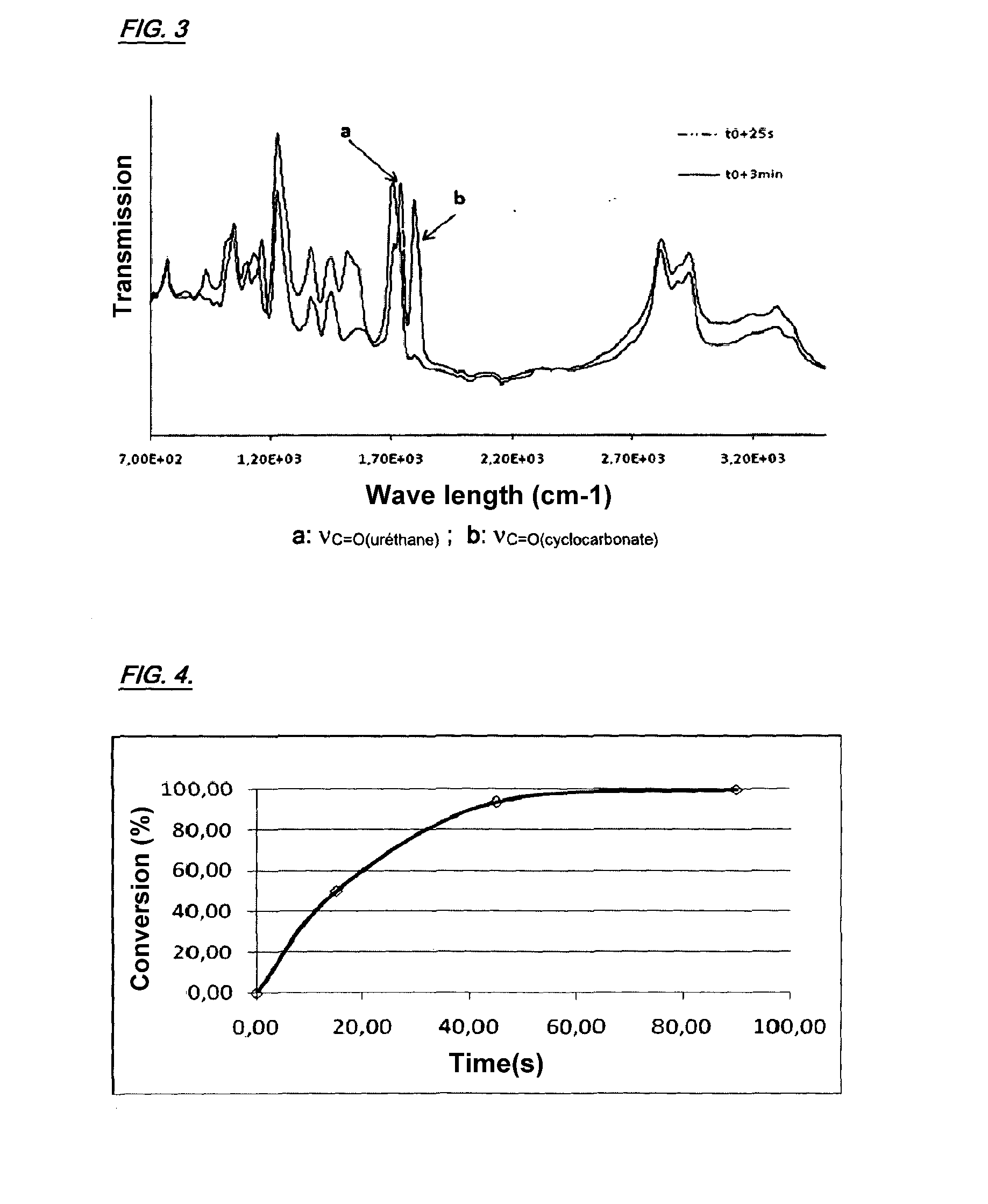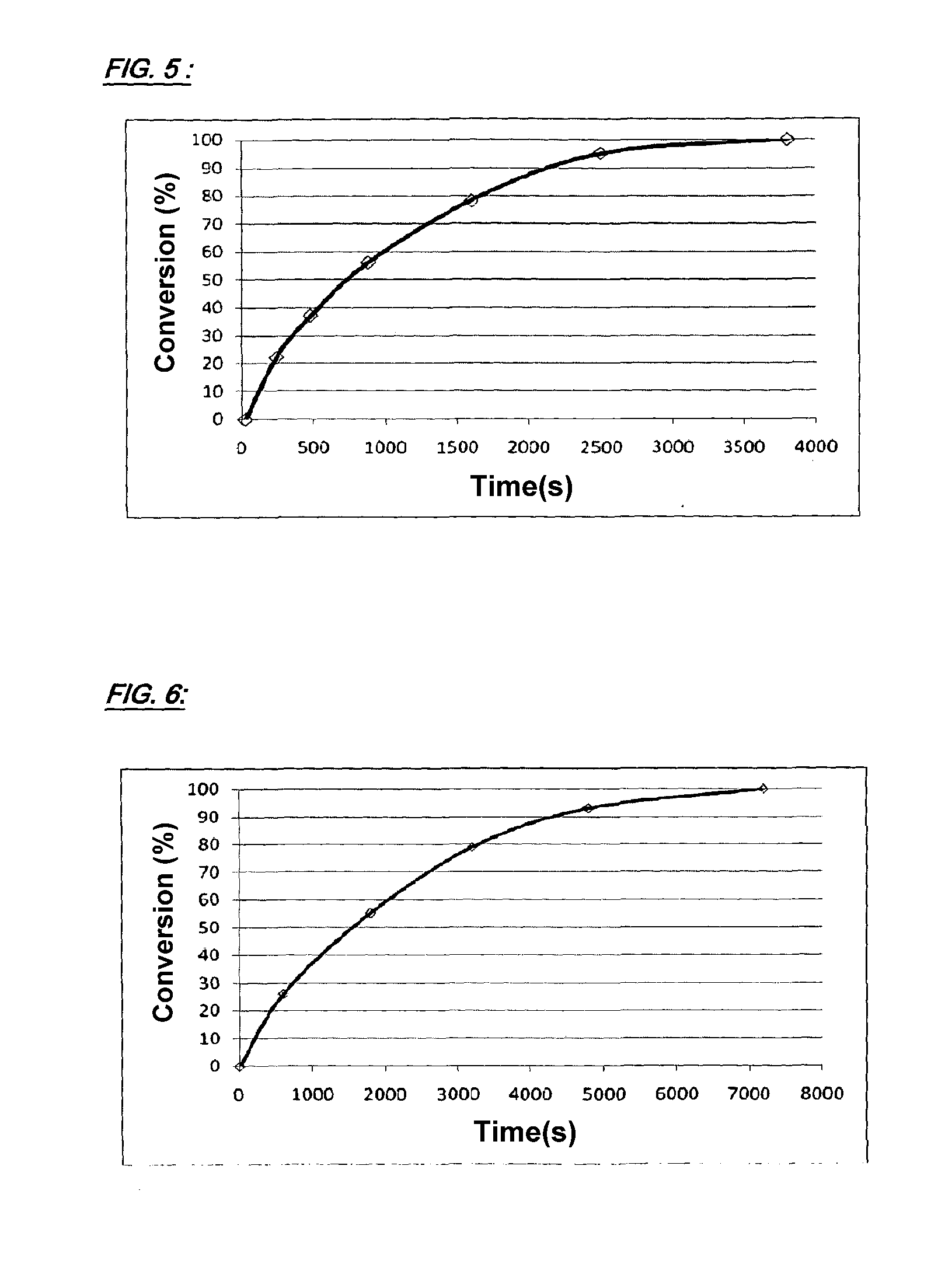Method for preparing a compound comprising at least one beta-hydroxy-urethane unit and/or at least one upsilon-hydroxy-urethane unit
- Summary
- Abstract
- Description
- Claims
- Application Information
AI Technical Summary
Benefits of technology
Problems solved by technology
Method used
Image
Examples
example 1
Comparative Study of the Catalytic Activity of Catalysts Used in the Reaction Between a Cyclocarbonate Compound and a Diamine
[0156]In this example, the catalytic activity of the catalyst comprising tris(2,4-pentanedione) chromium (III) (SACHEM Europe BV), and optionally combined with triethylamine, was compared to the catalysts suggested in the known methods of the prior art catalysts, namely betaine (Sigma), tetraethylammonium hydroxide (Aldrich), 2-hydroxypyridine (Aldrich), tetraethylammonium tetrafluoroborate (Aldrich), tetramethylammonium bromide (Aldrich), triphenylphosphine (Aldrich), triethylamine (Sigma Aldrich), calcium carbonate (Aldrich). This study was carried out on the condensation reaction between trimethyl diamine (TMD Vestamin, Evonik) and 4-(hydroxymethyl)-1,3-dioxolan-2-one (Huntsman). The series of experiments carried out is explained in Table 1.
TABLE 1Experimental conditions of the study of various catalytic activities of the catalysts tested in the condensatio...
example 2
Catalysis by the System tris(2,4-pentanedione) chromium (III) / triethylamine with Addition of trimethylhexamethylenediamine on (2-oxo-1,3-dioxolan-4-yl)methyl acetate
1. Preparation of (2-oxo-1,3-dioxolan-4-yl)methyl acetate
[0162]In a two-necked 250 ml flask fitted with a condenser, are introduced respectively: 4-(hydroxymethyl)-1,3-dioxolan-2-one (29.00 g, 0.22 mol), acetic anhydride (22.20 g, 0.21 mol, Sigma, Aldrich) and 2 drops of pure sulfuric acid. The reaction mixture, placed under mechanical agitation, is heated to 60° C., in air and at atmospheric pressure for 45 minutes.
[0163]The crude reactive is taken up in 80 ml of chloroform. The organic phase is washed ten times with 200 ml of distilled water, then dried over anhydrous magnesium sulfate.
[0164]The chloroform is evaporated in vacuo. The product is concentrated in a rotary evaporator under vacuum at 40° C. 20 g of a yellow low viscosity oil are obtained (yield=39.2%).
[0165]RMN1H(DMSO): δ=2.5 ppm (3H, C4H), 4.65 ppm (1H, C1...
example 3
Catalysis by the system tris(2,4-pentanedione) chromium (III) / triethylamine addition of tetraethylene pentamine on 4-(hydroxymethyl)-1,3-dioxolan-2-one
[0169]In a test tube were introduced in the absence of solvent, the 4-(hydroxymethyl)-1,3-dioxolan-2-one (3.00 g, 25.4 mmol), tetraethylene pentamine (5.10 g, 25, 4 mmol, Huntsman), tris(2,4-pentanedione) chromium (III) (12.80 mg, 0.04 mmol) and triethylamine (3.84 mg, 0.04 mmol). The reaction mixture, placed under mechanical agitation, is left at ambiant temperature in air and at atmospheric pressure.
[0170]The conversion of 4-(hydroxymethyl)-1,3-dioxolan-2-one corresponding hydroxyuréthane was followed by FTIR, following the protocol described in Example 1. The results obtained are shown in FIG. 4.
[0171]From the data presented in FIG. 4, it is clear that the introduction of catalytic amounts of tris(2,4-pentanedione) chromium (III) and triethylamine enables attainment of a quantitative consumption at ambiant temperature of 4-(hydroxy...
PUM
| Property | Measurement | Unit |
|---|---|---|
| Dimensionless property | aaaaa | aaaaa |
| Ratio | aaaaa | aaaaa |
| Molar ratio | aaaaa | aaaaa |
Abstract
Description
Claims
Application Information
 Login to View More
Login to View More - R&D
- Intellectual Property
- Life Sciences
- Materials
- Tech Scout
- Unparalleled Data Quality
- Higher Quality Content
- 60% Fewer Hallucinations
Browse by: Latest US Patents, China's latest patents, Technical Efficacy Thesaurus, Application Domain, Technology Topic, Popular Technical Reports.
© 2025 PatSnap. All rights reserved.Legal|Privacy policy|Modern Slavery Act Transparency Statement|Sitemap|About US| Contact US: help@patsnap.com



